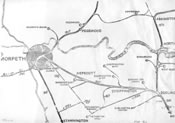Click on images to view full size.
If the North East is the cradle of the railways, South East Northumberland could certainly be considered the feeding-bottle, since it was at Killingworth Colliery, the site of which you can see as you travel into Newcastle from Morpeth, that George Stephenson developed the engines that he knew could pull both freight and passengers and make a national railway network possible. The whole area is criss-crossed with the tracks left by that era, from the wagonway at Plessey which is said to date back to the sixteenth century, and of which there is nothing left but a grassy mound across a field, to the remains of the Blyth and Tyne railway which at one time was set to be an alternative route to the North, and which is still in working order as a freight line. In focusing on the history of the railways in this area, SENRUG wants to show that the baby is still as vital as ever, although it does need nurturing!
 Morpeth Map Morpeth was always geographically well placed to be at the centre of this hub of railways, and at one time it was a major junction,as the accompanying map shows. The substantial range of stone buildings on the site testifies to a time when there were two major stations here, one the grand through station in 'Scottish Baronial' style, and the other the terminus for the Blyth and Tyne railway, which was the last of the old independent railways to be subsumed into the North Eastern Railway in 1874. A third railway, the North British, used to enter the town from the west from Scots Gap. The course of this old railway can be traced west from the golf course, and eastwards through the town on old stone abutments that used to carry it into the Blyth and Tyne terminus. The North British wanted their own route through to Scotland rather than sharing with the York, Newcastle and Berwick which went straight through Morpeth up to Edinburgh.
Morpeth Map Morpeth was always geographically well placed to be at the centre of this hub of railways, and at one time it was a major junction,as the accompanying map shows. The substantial range of stone buildings on the site testifies to a time when there were two major stations here, one the grand through station in 'Scottish Baronial' style, and the other the terminus for the Blyth and Tyne railway, which was the last of the old independent railways to be subsumed into the North Eastern Railway in 1874. A third railway, the North British, used to enter the town from the west from Scots Gap. The course of this old railway can be traced west from the golf course, and eastwards through the town on old stone abutments that used to carry it into the Blyth and Tyne terminus. The North British wanted their own route through to Scotland rather than sharing with the York, Newcastle and Berwick which went straight through Morpeth up to Edinburgh.
The idea of a main line across the moors to Hawick proved to be a bit of wishful thinking when the North British were faced with the actual receipts from passengers and freight, but that did not stop the line from staying open until the mid sixties.
Along the same route, until it diverged at Scots Gap, went the "Wannie Line" of local legend, a branch line that was again started as an alternative route to Scotland but which eventually only got as far as Rothbury. The trains on this picturesque route, which ran through one of the most sparsely populated areas of the country used to terminate behind the down platform on the west side of the station. You can still see the lines on this side, and the wider part of the bridge over the road that used to accommodate the branch line. Much as SENRUG would like to revive the sights and sounds of this delightful country branch line, prudence dictates that this would be more of a long-term project & the Blyth and Tyne is at least still intact, and obviously making enough money on freight to make it a viable proposition even to the present day. This was the way many of the old railways survived through the bad times, keeping going on freight receipts while waiting for passenger numbers to pick up. Our contention would be that passenger numbers are there for the taking, to any operator who wants to pick up the baton!
Morpeth clings on to its position in the national network, with one intercity train stopping at 7.20 in the morning, and one London train in the evening at 8.43, in addition to a more or less hourly service through Newcastle to the Metro Centre. However, SENRUG`s contention is that these services are not commensurate with the status of a county town which contains the county offices as well as being an important centre for Northumberland itself. Alnmouth has more stopping intercity trains, and whereas we would support this in every way, we would also feel that parity at least would be not only a fair but also a reasonable division of the railway`s resources in the North East.
Morpeth`s station, a grand entrance to the town for visitors, was built in 1847 by Benjamin Green, and the photographs of it in the early days show how it was built some way from the town centre at a time when there was little building in that direction. The famous 'Morpeth curve' to the south of the station was also forced on the railway engineers by the geographical position of the town, and since it goes through ninety degrees, it has forced itself on the attention of railway timetablers since, a reduction in speed being inevitable. Indeed, it was a major bone of contention in the 'Railway Races to the North' of the 1890`s, the East Coast route complaining bitterly that they had a major disadvantage with the Morpeth curve on their line! It is certainly the severest curve on any main line in Britain, and if as is projected, a tunnel goes under the Straits of Gibraltar eventually, it could also be the severest curve between Thurso and Cape Town ! It has been the cause of three major accidents, the first in May 1969, the second in March 1977 and the third in June 1984. All of these unfortunately led to fatalities, and in 1994 a mail train overturned on the curve. In the 1969 crash the leading van of the train damaged part of the overall roof of the northbound platform. It could have been repaired but was removed altogether, which is why only one platform has a canopy now.
So that is Morpeth as we see it today, and our point would be, first, restore a still handsome station to its rightful status as a junction to serve not only Morpeth but Ashington, Blyth, Seaton Delaval and Bedlington; secondly, since trains stop and slow down here already too many times by geographical accident, why not make them stop more on purpose? We hope you will enjoy looking at the gallery of photos of Morpeth past and present, and that you will also enjoy a visit one day when you may see some of the details that make this station a fascinating monument to the past as well as an elegant entrance lobby to what in our humble opinion is still the best way to travel ! Look out especially for the North Eastern Railway tile map, one of the very few that still exist in situ, showing the vast extent of the North East Railway`s network in the early 1900s; the iron gates at the end of the subway which are pre-1923, the post box from the reign of Queen Victoria, and the remains of a drinking fountain close by which is a relic from days past, and a clear reminder of the public spirit which was the origin of the railways.
SENRUG would like to thank the Darlington Railway Museum, the J.W. Armstrong Trust and John Earl for the use of their photographs and those in their collections. The J.W. Armstrong Trust can be contacted at J.W. Armstrong Trust, c/o Station House, Penshaw, Houghton le Spring, Co. Durham, DH4 7PQ
John Earl
Back to More...



















